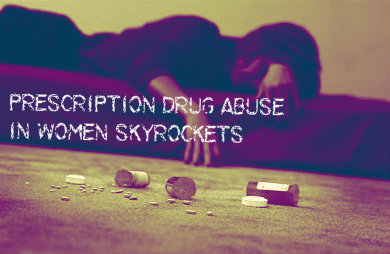Prescription Drug Abuse In Women Skyrockets
Deaths among women from prescription pain medications are on a steep incline, according to a recent study by the Centers for Disease Control and Prevention (CDC). The study reported that deaths among women due to prescription painkiller abuse grew five-fold from 1999 to 2000. During the same time period, deaths from prescription painkiller overdoses among men grew by 3 ½ times its previous rate. This report highlights the longstanding problem of widespread abuse of prescription pain drugs among women—a problem that has often been overlooked or minimized.
Drug abuse in general, including abuse of prescription painkillers, is often viewed as a bigger problem for men than for women. While it is true that men do make up a larger percentage of all drug abusers, prescription painkiller abuse has affected women in larger numbers for more than a century. And while there are still more yearly deaths among men from prescription drugs—including prescription painkillers—the rapid spike in deaths among women in recent years means that the gender gap is quickly closing.
Painkiller Abuse In The 19th Century
 Epidemiological reports from the 19th century estimate that women made up 65 percent to 75 percent of all individuals addicted to opium. This was often the result of self-medication, the use of unregulated “patent” medicines, or irresponsible and inappropriate prescriptions on the part of qualified physicians. In this century, women were often unnecessarily medicated even by qualified professionals due to the prevailing belief of the time that women were fragile and unable to cope with physical pain or emotional distress without assistance. Women were often treated for a vague complaint known as neurasthenia—characterized primarily by fatigue, headaches and irritability—as well as other “disorders” whose existence have now been largely discredited.
Epidemiological reports from the 19th century estimate that women made up 65 percent to 75 percent of all individuals addicted to opium. This was often the result of self-medication, the use of unregulated “patent” medicines, or irresponsible and inappropriate prescriptions on the part of qualified physicians. In this century, women were often unnecessarily medicated even by qualified professionals due to the prevailing belief of the time that women were fragile and unable to cope with physical pain or emotional distress without assistance. Women were often treated for a vague complaint known as neurasthenia—characterized primarily by fatigue, headaches and irritability—as well as other “disorders” whose existence have now been largely discredited.
Modern Drug Use Among Women
As early as the 1960s, studies have shown that women make up the majority of prescription drug users in the United States. This includes painkillers, psychoactive medications and antidepressants.
There are a variety of possible reasons for this gender imbalance. For example, modern studies have provided evidence that women experience more chronic pain than men do, or at least seek treatment for chronic pain more frequently. Women who use prescription medications report many other factors that contributed to their decision to seek treatment for physical or mental distress. These factors often include gender discrimination in work or social settings, the economic and emotional challenges of being the primary caregiver or a single parent, and societal expectations.
Studies have show that when women are prescribed pain medication, they are more likely to be given higher doses and medicated for a longer period of time than their male counterparts. One possible explanation for this phenomenon is that men remain more likely to have jobs involving manual labor with high risk of short-term injuries. In contrast, women are more likely to experience chronic pain when reaching middle age and seek treatment over a long period of time.
With a large and rapidly growing number of women taking prescription painkillers, the odds increase that a certain number of these women will develop physical dependencies. Many prescription pain medications, including Vicodin and morphine, are opioid drugs that are highly addictive.
Equal Opportunity Drug Abuse
Since as early as the 1920s, the overwhelming majority of drug users among men have been from minority populations and economically disadvantaged backgrounds. In contrast, prescription drug abuse among women has always affected a much more varied population, from the wealthy to the working classes. Although white and Native American populations have the highest numbers of deaths from prescription painkillers, the problem is by no means unique to those demographic groups.
While women who abuse prescription painkillers do not come from one predominant economic situation or ethnicity, there is a strong trend apparent when it comes to age. The rate of deaths from prescription painkillers more than tripled among women ages 45 through 54, and also tripled for women ages 55 through 64. In the year 2010, middle-aged women in these age groups made up almost half of the overall deaths among women from drug overdoses.



